-
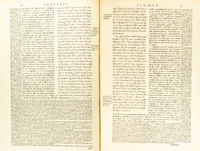
This edition of the Timaeus contains the translation and notes of Jean de Serres (1540-1598), a Calvinist Huguenot who sought to extirpate Neoplatonic elements from translation and commentary on Platonic works. Serres’ aim was to perceive the doctrine of Plato through study of the original texts. His work was published in 1578 by fellow Huguenot Henri II Estienne (1528/1531-1598) and dedicated to Queen Elizabeth I. The famous reference system known as “Stephanus pagination” was based upon the numbering in this edition of the Platonic corpus. The Latin translation of each Platonic dialogue is set alongside an edition of the original Greek text. Marginal notes give references to other philosophical texts, such as Cicero. Notably, Serres’ explanations do not refer to popular Neoplatonic commentaries such as those by Calcidius and Proclus. The pages displayed correspond to the section of the Timaeus in which the composition and other characteristics of the world’s body are described.
-
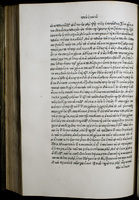
This book is part of the editio princeps of the Aristotelian corpus, which Aldus Manutius (1449/1450-1515) published himself in five folio volumes at Venice in 1495. Manutius was famous for his devotion to ancient Greek literature; he wished to save the Greek corpus from further loss by committing as many works as possible to type. He also developed the typeface style known as italic. Manutius’ edition of Aristotle was the first major Greek prose corpus to be printed in its original language and set the standard for the development of Greek type in the fifteenth century. The pages displayed include a passage from De Caelo in which Aristotle mentions the receptacle described in Plato’s Timaeus as the receiver of all things. This passage, De Caelo 306b15-22, begins in line 10 on the left page shown with the words
Ἀλλ’ ἔοικεν ἡ φύσις.
-

This diminutive codex contains a portion of Marsilio Ficino’s Platonis Opera Omnia. Simon Grynaeus (1493-1541), an anonymous Lyonnaise editor, and Estienne Tremblay (1556-1597) have all revised the text appearing in this edition. Jacobus Stoer printed this three-volume edition of Ficino’s text at Geneva in 1592. The volumes are small enough to be used as portable reading material. Marginal notes of two sorts are found in this translation. Notes in normal type give different readings or translations of the text along with the scholar from whom these readings stem; scholars cited include Cicero and Proclus. Notes in italics are topical headings or interpretations of the text. The pages displayed translate the Timaeus passage in which the periods of heavenly bodies and the completion of the Perfect Year are described, as well as the creation of stars and gods.
-
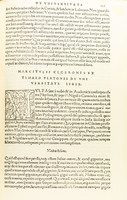
This book is the fourth volume in an edition of Cicero’s works published at Venice by Luca Antonius Junta between 1534 and 1537. This particular volume was printed in 1536 and contains some of Cicero’s philosophic texts. The pages displayed show the beginning of his partial translation of Plato’s Timaeus. The portion shown includes the preface, in which Cicero links Platonic doctrines with Nigidius Figulus (98-45 B.C.E) and Roman Pythagorianism; the translation follows, beginning with Timaeus’ opening questions and explanation thereof: “What is that which always is and has no becoming, and what is that which becomes but never is?” The translation ends at Timaeus 47b, with the discussion regarding the purpose of eyesight and its crucial role in philosophy. Cicero’s translation was read by a number of well-known late antique scholars and had great influence on subsequent translations of the Timaeus.
-
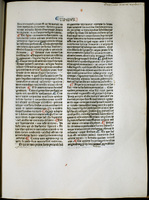
This volume, printed in 1484 in Florence, contains the Platonis Opera Omnia of Marsilio Ficino (1433-1499) – the leading Plato scholar of the 15th century, head of the Platonic Academy in Florence, and first translator of Plato’s complete extant works into Latin. The translation of the Timaeus is prefaced by Ficino’s commentary on the work, titled Compendium in Timeum. It is possible that Ficino chose to publish in 1484 because of its astrological significance – the conjunction of Saturn and Jupiter (which he mentions in the argument to one of Plato’s Letters) was supposed to herald great changes in Christianity. The pages displayed translate the portion of the Timaeus in which the lesser gods are created and proceed to create human beings. These pages also bear traces of a later reader. S/he has marked the second column of the left page with marginal lines and an abbreviation meaning Nota bene (“mark well”). The right page includes several corrections written in the text. At the top of the right page, the emender has written a testimony to conscientious reading:
Doctus lector errores vitabit (“The learned reader will shun errors”).
-
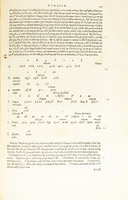
This volume contains the second Greek edition of the Platonic corpus, edited by Johannes Oporinus and Simon Grynaeus; the text is based upon the Aldine edition of 1513. The book was printed at Basel by Joannes Valderum in March 1534. In addition to the text of Platonic works, the edition contains commentaries by Proclus on the Timaeus and the Republic. Notes in Latin, Greek, and French have been written throughout the volume. These notes often comment upon different readings of the text, citing sources including Cicero, Calcidius, and Proclus; printing errors are also pointed out and corrected*. The pages displayed are from the section of the Timaeus in which the composition of the world’s body and soul is described. The chart on the right page relates to Proclus’ commentary on the Timaeus 35b-36b, where Plato states that the Demiurge created harmonious divisions of the world soul. Conforming to Pythagorean numerology, Plato’s conception of harmony, music, and geometry depended upon integer multiples and divisions:
2 x 1 = 2 2 x 2 = 4 2 x 4 = 8
3 x 1 = 3 3 x 3 = 9 3 x 9 = 27
These integer relationships form musical intervals.
2:1 = octave
3:1 = double octave
3:2 = fifth
Ancient Greek studies in acoustics produced mathematical arrangements of proportions in order to establish their scale. Thus, the proportions represented in the second horizontal line are:
432:384 = 9:8 (wholetone)
486:432 = 9:8 (wholetone)
512:486 = 256:243 (leimma, i.e. halftone)
576:512 = 9:8 (wholetone)
648:576 = 9:8 (wholetone)
729:648 = 9:8 (wholetone)
These intervals form a musical scale. The subsequent lines in the chart give similar proportions in greater multiples.
-
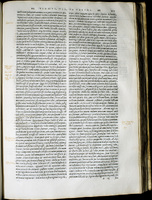
This volume contains an edition of Marsilio Ficino’s Platonis Opera Omnia that was emended and collated with a Greek text by Simon Grynaeus (1493-1541). Grynaeus was a renowned Protestant humanist who shared friendships with Erasmus and Budé. He is the first major revisor of Ficino’s work. Grynaeus’ edition of Ficino’s text was first published in 1532. In his preface, Grynaeus proclaims his admiration of Ficino and his desire to make Platonic doctrine more available to all. He justifies the new edition by stating that he had collated Ficino’s work with a Greek exemplar (the Aldine Greek edition). However, Grynaeus probably also disliked Ficino’s style; he actively attempts to revise Ficino’s Latin in accordance with classical usage. The volume shown here is a reprint of the 1532 edition with the addition of a new index, printed by Giovanni Maria Bonelli at Venice in 1556. The pages displayed translate the Timaeus passage 18a-24d– the beginning of Critias’ account of Solon’s visit to Egypt. A fine Italic hand has written topical captions in the margins.
-

The Uranometria, published by the lawyer and amateur astronomer Johann Bayer (1572-1625), was the first astronomical work to be considered a collection of star maps (rather than symbolic pictures). It was printed at Augsburg by Christopher Mangus in 1603, and the elaborate copperplate engravings were done by Alexander Mair. One important feature of Bayer’s atlas is his new system of stellar nomenclature—he assigned Greek letters to brighter stars, generally by order of magnitude. The plate displayed is Bayer’s map of the constellation Cancer.
-
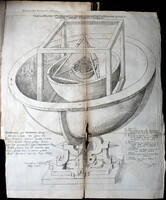
Published at Frankfurt by Erasmus Kempfer, this volume contains the second edition of the astronomical work, Mysterium Cosmographicum (originally published in 1596) by Johannes Kepler (1571-1630), along with copious notes by Kepler himself. The Mysterius Cosmographicum was the first published defense of the Copernican heliocentric system. It was in this work that Kepler believed he had uncovered God’s geometrical plan for the universe – he proposed a model of the solar system using nested Platonic solids. The page displayed illustrates his distinctive model of the universe.
-
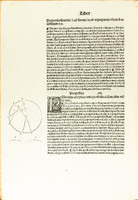
Georg von Peurbach (1426-1461) began work on this condensed version of Ptolemy’s Almagest; his pupil and friend Johannes Müller von Königsberg (1436-1476), known by the pseudonym Regiomontanus, finished it. Printed at Venice by Johannes Hamman in 1496, the book became a renowned astronomical guide. Columbus and Copernicus were introduced to Ptolemy’s work via this epitome. The work includes a woodcut portrait of Ptolemy and Regiomontanus underneath a large celestial sphere. This portrait shows Ptolemy reading from the Almagest while Regiomontanus listens and points to the celestial sphere – a representation of the heavenly order described in Ptolemy’s work. The pages displayed here are from the eighth book of the epitome, the section covering positions of the stars.
-
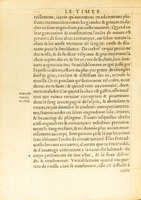
This translation and commentary on the Timaeus by the humanist Loys le Roy (1510?-1577) contains the first known translation of the dialogue from Greek into French. The volume belongs to the second printing of Le Roy’s translation, produced in Paris by Abel l’Angelier in 1582 (click here to see the title page). It also contains a French translation of Plutarch’s treatise on the creation of the soul., an event which Plato describes in the Timaeus. The text is divided into four parts, although the precise point of division between the third and fourth parts is uncertain. Marginal numbers, such as the ‘4’ printed on the left page displayed, direct the reader to endnotes printed after the section. Simple diagrams are printed occasionally throughout the work. The Timaeus passage shown treats bodily diseases, particularly how they arise and are propogated. The Greek note in the margin is a direct quotation from Timaeus 82e: ὅταν γὰρ τηκομένη σάρξ, meaning “whenever flesh decomposes.”
-

Jacobus Tapia Aldana edited and corrected this edition of Marsilio Ficino’s Platonis Opera Omnia. The volume, which includes a detailed index, was printed at Venice by Hieronymus Scotus in 1571. The pages displayed correspond to the Timaeus passage29d-38e. Subjects covered in this section include the reason for the creation of the world, the composition of the world’s body and soul, the union of the world’s soul with its body, and the creation of time. Brief topical captions have been written in the margins of the text.
-
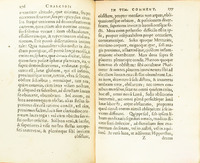
This volume contains a seventeenth-century edition of the Latin translation and commentary on the Timaeus originally produced by Calcidius in the fourth century. Calcidius’ translation, which ends at Timaeus 53c, is more complete than the one produced by Cicero. The medieval reception of Plato relied heavily upon Calcidius’ translation and commentary, which employed material from Middle and Neoplatonic sources to interpret the Timaeus. Calcidius’ work was studied widely throughout the Middle Ages and kindled a long tradition of glosses on the Timaeus. Critics note that Calcidean concepts soon became intermingled with Platonic doctrines. The displayed copy of Calcidius’ text was edited by the Dutch scholar Johannes Meursius (1579-1639), who provided additional notes in Greek and Latin on the translation. He also compiled the accompanying index of Platonic words and topics. The volume was printed in Leiden by Justus à Colster in 1617. The pages shown are from Calcidius’ commentary on the Timaeus, in particular from the section treating the motions of the stars.
-
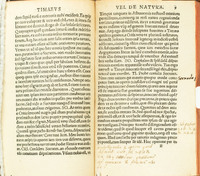
This volume contains Marsilio Ficino’s Latin translation of the Timaeus, edited by Francisco Zampino. The text was printed in Paris by Prigent Calvarin in 1536 (a reprint of the original 1527 edition) and later bound together with four other texts published between 1532 and 1557 by various printers. These texts include the following works: Alcinous’ Philosophi ad Platonis Dogmata Introductio and Philosophi Platonici de Doctrina Platonis Liber, Speusippus’ Platonis Discipuli Liber de Platonis Definitionibus, Xenocrates’ Philosophi Platonici Liber de Morte, Marsilio Ficino’s translation of Plato’s Phaedo, Demetrius Phalereus’ De Elocutione Liber, and the Opuscula of Dionysius of Halicarnassus. In order to bind the Timaeus with these other texts, the pages had to be cut down to a uniform size. This process caused the truncation of certain marginal notes written prior to the rebinding. These notes reference other commentators on the Timaeus, including Cicero, Proclus, and Calcidius. The pages displayed translate a passage from the beginning of the Timaeus in which Critias concludes Solon’s story and Timaeus begins his cosmological speech.
-
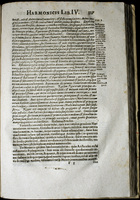
This volume is a first edition of Johannes Kepler’s Harmonices Mundi, printed by Johannes Plancus at Linz (Austria) in 1619. In this work, Kepler explains his vision of harmony and congruence in geometrical forms and in the physical world. This vision of harmony focuses upon his conception of musica universalis – the “music of the spheres,” which had been studied by earlier astronomers (including Ptolemy). He also details his discovery of the Third Law of planetary motion. The pages displayed include a lengthy quotation from Proclus and a marginal note indicating that Kepler considered Plato’s Timaeus as a commentary on the biblical book of Genesis.
-
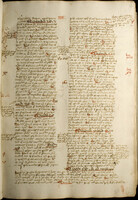
This manuscript contains, among other material, anonymous commentaries on a number of Aristotelian works. Multiple fifteenth-century hands are represented in the manuscript, and some of the scribes give their names. Judging by the extensive notes and highlighting throughout the volume, this codex probably belonged to a student. The pages displayed contain a commentary on book IV of Aristotle’s Physics with many marginal notes. The right page includes a passage discussing Plato’s conception of space and matter (which Aristotle mentions in Physics 209b). While the cursive hand is very difficult to read, there is an abbreviation (plto) roughly in the middle of the right column that probably represents “Plato.” It is also possible to make out the phrase antiqui phī (“ancient philosopher,” the second word being an abbreviation for philosophi) in this section.















